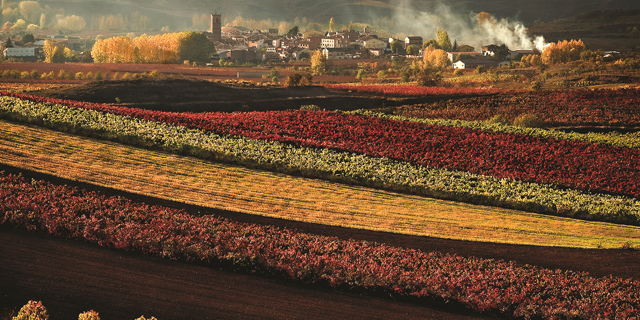Recently, a team of scientists at GlaxoSmithKline, led by Harvard geneticist David Sinclair, have found that synthetic versions of resveratrol, a chemical found in red wine, may effectively slow the aging process and illness, muscle wasting, cataracts, and skin conditions. Tempranillo, our featured wine of the month, just got a whole lot more attractive!
Tempranillo: the name of this typical Spanish red wine rolls off the tongue just as easily as it goes down after a sip. If you’re drinking red wine from Spain, it probably has some Tempranillo in it, as it’s the number one grape native to the country. These grapes fill the bottles of most red wines from the famous Rioja area in the Ebro River region, in addition to other regions all across Spain. Much of the time it stands alone, but often it’s the main component in a balanced blend.
Tempranillo grows exceptionally well in many regions of Spain: the many microclimates in which it thrives make for wines with such different characteristics that they’ve given the same grape different names depending on where it’s grown. Abundante, Cencibel, Tinto de Madrid, Tinto de Toro, Tinto del País, and Tinto Fino, are all just other names meaning Tempranillo.
For novice red wine drinkers, Tempranillo is easy to drink—smooth and soft without too much acidity or tannins. But with the right level of complexity of flavors, serious red drinkers can be sated too. In Spain, whether at a restaurant, tapas bar, or at home, Tempranillo is always on the table with a meal.
If you’re sitting over a steaming bowl of beef stew on a cold winter night, Tempranillo is your wine. Grilling steak or lamb at a summer barbecue? Everyone will be happy with some Tempranillo. Let’s not forget cheese. Red wines can sometimes be difficult to pair with cheese since they tend to overpower, but not this one varietal. Salty cheeses, cow’s and sheep’s milk cheeses, and cheeses from Spain like Mahon and Manchego bring out the best in Tempranillos.
Whether you're trying to please a crowd or stock your wine, move Tempranillo to the top of your list. Here’s a quick breakdown of what you need to know.
Label Lingo
You might not even see the name Tempranillo on the bottle. Look for the others mentioned above, or just know you’ll be getting it if the label calls out the areas of Rioja, Ribera del Duero, or Toro. These will be the highest quality Tempranillos.
Taste
Smooth and round with earthy flavors. You might notice hints of cherry, spices, cocoa, berries, or tobacco.
Pairings
Beef, lamb, chorizo, jamón, hearty green vegetables like broccoli and Brussels sprouts. Try pairing it with: Ecuadorian Lamb, Stew Coriander Crusted New York Steak, Coffee & Cocoa Encrusted Steak with Orange-Chipotle Honey Glaze, or Picadillo.
Recommendations
Try some of our favorites: Protos (Ribera del Duero), Bodegas Montecillo (Rioja), or El Coto (Rioja).
Once you've found a wine you love, have a glass every night – it might help you live longer, really! A team of scientists at GlaxoSmithKline, led by Harvard geneticist David Sinclair, have found that synthetic versions of resveratrol, a chemical found in red wine, may effectively slow the aging process. In fact, more than 100 drug trials have shown the chemical can slow illness, muscle wasting, cataracts, and skin conditions. Sinclair even said that because of resveratrol, "some of us could live to 150." Now, there's something to cheers.


![Making Mealtime Matter with La Familia: Easy Sofrito [Video]](https://thelatinkitchen.com/wp-content/uploads/2015/10/sofrito-shutterstock__0-500x383.jpg)
![Easy Latin Smoothies: Goji Berry Smoothie [Video]](https://thelatinkitchen.com/wp-content/uploads/2015/12/goji_berry-shutterstock_-500x383.jpg)
















![Fun and Fast Recipes: Fiesta Cabbage Salad [Video]](https://thelatinkitchen.com/wp-content/uploads/2015/11/fiesta_cabbage_slaw-shutterstock_-500x383.jpg)









